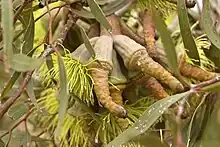| Warted yate | |
|---|---|
 | |
| Scientific classification | |
| Kingdom: | Plantae |
| Clade: | Tracheophytes |
| Clade: | Angiosperms |
| Clade: | Eudicots |
| Clade: | Rosids |
| Order: | Myrtales |
| Family: | Myrtaceae |
| Genus: | Eucalyptus |
| Species: | E. megacornuta |
| Binomial name | |
| Eucalyptus megacornuta | |

.jpg.webp)
Eucalyptus megacornuta, also known as warted yate or warty yate,[2] is a species of Eucalyptus that is endemic to the south-west of Western Australia.[3]
Description
The tree typically grows to a height of 4 to 12 metres (13 to 39 ft)[3] with a crown of up to about 6 m (20 ft) wide. E. megacornuta has the habit of a small tree or shrub with a smooth brown to grey-red and green trunk[2] and smooth bark over the length of the trunk and branches. The dull, green, thick and concolorous adult leaves have a disjunct arrangement. The leaf blade has lanceolate to elliptic shape that is basally tapered.[4]
It produces large yellow-green flowers that occur from July to October in the species' native range.[3] Each simple, axillary conflorescence is made up of three to seven flowered umbellasters on broadly flattened peduncles.[4] The fruits or capsules are clustered and sessile on a flattened peduncle. They have a campanulate shape with one prominent rib with many weak ribs. The capsules are 1.8 to 4 centimetres (0.7 to 1.6 in) in length and 2.2 to 2.5 cm (0.9 to 1.0 in) wide with three exserted valves.[5]
Taxonomy
The species was formally described by botanist Charles Austin Gardner in 1942[6] as part of the work Contributiones Florae Australiae Occidentalis as published in the Journal of the Royal Society of Western Australia.[7] The type specimen was collected by Gardner in 1935 near Ravensthorpe.[4] The specific epithet (megacornuta) means "large-horned", referring to the operculum.[8]
E. megacornuta is very similar in appearance to the closely related Beaufort Inlet Mallee (Eucalyptus newbeyi) and Burdett's mallee (Eucalyptus burdettiana).[9]
Distribution
The species is found on hillsides and in creek beds along the south coast in the Great Southern and Goldfields-Esperance region of Western Australia between Albany and Hopetoun,[3] particularly in the Ravensthorpe Range,[2] where it grows in loamy alluvium soils over granite or laterite.
Conservation status
Eucalyptus megacornuta is listed as "endangered" under the Australian Government Environment Protection and Biodiversity Conservation Act 1999[9] but as "not threatened" by the Western Australian Government Department of Parks and Wildlife.[3]
Use in horticulture
The species is sold commercially in seed for or as tube stock, it grows well in full or par sun and is drought tolerant once established. A fast growing plant it can be used as an ornamental or privacy screening. The tree produces abundant nectar when it flowers so it is prized by apiarists and is a good bird attractor. The dried seed pods are also used in flower arrangements.[2]
See also
References
- ↑ "Eucalyptus megacornuta". Australian Plant Census. Retrieved 1 June 2020.
- 1 2 3 4 "Eucalyptus megacornuta". Australian Native Plants. Retrieved 11 December 2017.
- 1 2 3 4 5 "Eucalyptus megacornuta". FloraBase. Western Australian Government Department of Biodiversity, Conservation and Attractions.
- 1 2 3 "Eucalyptus megacornuta". Centre for Australian National Biodiversity Research. Retrieved 1 June 2020.
- ↑ "Factsheet Eucalyptus megacornuta". Dried Botanical ID. Retrieved 11 December 2017.
- ↑ "Eucalyptus megacornuta". Australian Plant Name Index (APNI), IBIS database. Centre for Plant Biodiversity Research, Australian Government, Canberra. Retrieved 9 April 2012.
- ↑ "Eucalyptus megacornuta C.A.Gardner". Atlas of Living Australia. Global Biodiversity Information Facility. Retrieved 11 December 2017.
- ↑ Sharr, Francis Aubi; George, Alex (2019). Western Australian Plant Names and Their Meanings (3rd ed.). Kardinya, WA: Four Gables Press. p. 250. ISBN 9780958034180.
- 1 2 "Approved Conservation Advice for Eucalyptus burdettiana (Burdett Gum)" (PDF). Department of Environment. 8 December 2008. Retrieved 11 December 2017.
